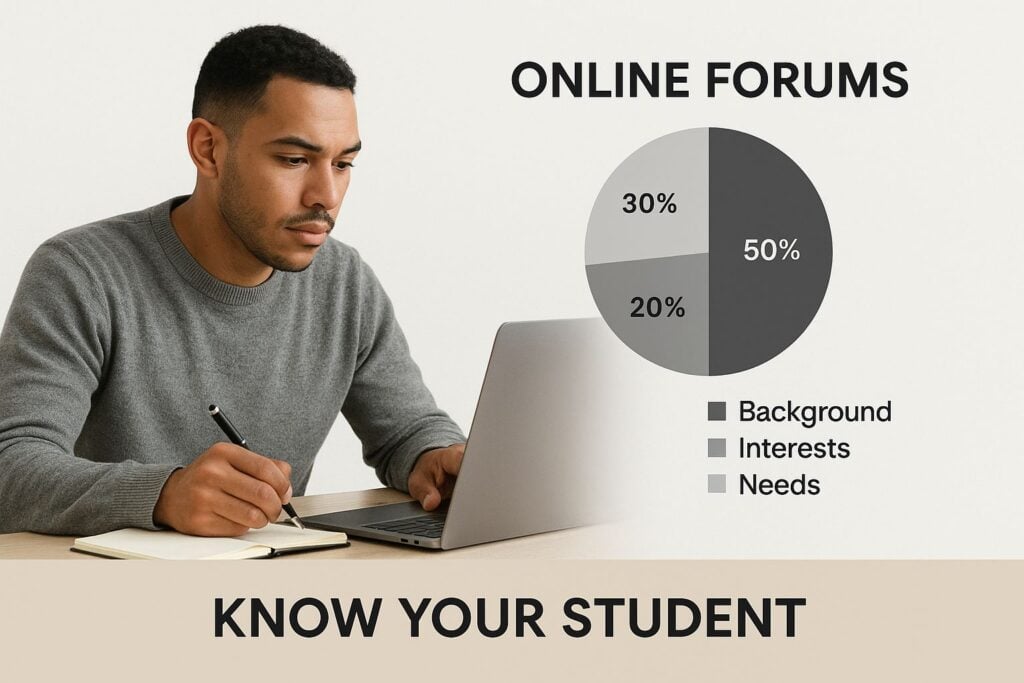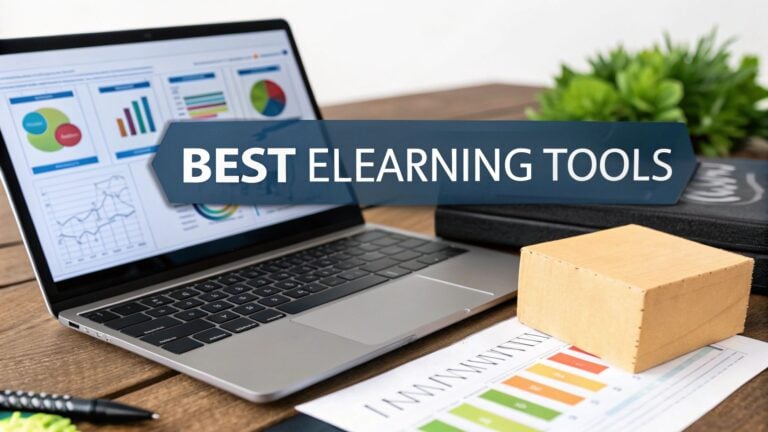How to Market an Online Course

Marketing an online course starts long before you ever hit “publish.” It involves deeply understanding a specific audience, building excitement before you launch, and creating content that genuinely solves their problems.
Everything hinges on knowing who your ideal student is, first and foremost.
Laying the Groundwork: Finding Your Ideal Student
Before you write a single word of a sales page or even think about a Facebook ad, you have to get laser-focused on who you’re trying to help. This goes way beyond basic demographics. I’m talking about creating a detailed “student avatar” which is a profile of one ideal person that feels so real you could sit down and have coffee with them.
When I first started, I made the classic mistake of trying to appeal to everyone. My marketing felt watered-down and, honestly, it fell flat. The game changed the moment I homed in on a single, specific person.
I got obsessed with understanding their exact frustrations, their biggest goals, and even the slang they used. Suddenly, my content started hitting home, and my marketing became 10 times more effective.
The first step to successfully marketing your online course is to understand how to identify your target audience. This is the bedrock that will support every single marketing decision you make from here on out.
The goal is to know your future student so well that you can describe their problems even better than they can. When you get to that point, they’ll automatically assume you have the solution.
Where to Find Your Ideal Students
So, where are these people hiding? They’re not hiding at all. They’re online, right now, talking about the very problems your course solves. You just need to know where to listen. Your mission is to become a detective, gathering clues about what truly drives them.
Online Forums and Communities: Places like Reddit, Quora, and niche Facebook Groups are absolute goldmines. Search for subreddits or groups related to your course topic. Pay close attention to the questions people are asking, the advice they’re giving, and the frustrations they keep venting about.
Competitor Reviews and Comments: What are people saying about other courses, books, or tools in your niche? Go straight to the 3-star reviews. These are often the most insightful, highlighting what was missing or what students really wanted. That feedback is a perfect roadmap for your own course content and marketing angles.
Social Media Polls and Questions: Don’t be afraid to just ask your existing audience. Use Instagram Stories polls or post simple questions on platforms like LinkedIn. Ask things like, “What’s the #1 thing you struggle with when it comes to [Your Topic]?” The responses you get are pure marketing intelligence.
This image perfectly captures the core idea: you need to meet your students where they already are.

This simple visual reinforces that all great marketing starts with empathetic research into your audience’s world. It’s about listening before you ever try to sell.
Building Your Student Avatar
Once you’ve gathered all this intel, it’s time to pull it together into a single, living document. Give your avatar a name. Find a stock photo. Make them feel like a real person.
Flesh out these key points:
- Demographics: Age, location, job title. (e.g., “Sarah, a 32-year-old freelance graphic designer in Austin.”)
- Goals & Aspirations: What are they trying to achieve? (e.g., “Wants to confidently charge higher rates and land bigger, more creative clients.”)
- Pains & Frustrations: What’s holding them back right now? (e.g., “Feels overwhelmed by endless client feedback and has no idea how to price her work fairly.”)
- Watering Holes: Where do they spend their time online? (e.g., “Active in the r/graphic_design subreddit and follows specific design influencers on Instagram.”)
This student avatar becomes your North Star. From now on, every piece of content, every email, and every social media post should be written as if you’re speaking directly to this one person. It’s the secret to making your marketing feel personal and resonant.
Build Pre-Launch Buzz and Grow Your Email List
One of the biggest mistakes I see new course creators make is waiting until their course is 100% finished to even think about marketing. It feels logical, right? But it’s like building a beautiful store in the middle of a desert and then hoping people find it.
We’re going to completely sidestep that problem by starting your marketing now.
The goal is to build genuine excitement and grow an email list of people who are not just interested but are eagerly waiting for you to open the doors. This is how you launch to an engaged audience instead of an empty room.
Your email list is the single most valuable asset in this entire process because you own it. It’s a direct line to your future students.

Create a High-Value Lead Magnet
A lead magnet is just a fancy term for a free, valuable piece of content you give someone in exchange for their email address. It’s the handshake that starts the relationship. It shouldn’t be your entire course, but it absolutely must solve one small, specific problem for your ideal student avatar.
This freebie needs to deliver a quick win. When someone uses your lead magnet and gets a tangible result, they immediately start to see you as a trusted expert.
Here are a few ideas I’ve seen work incredibly well:
- A Detailed Checklist: If your course is on “Beginner’s Guide to Sourdough Baking,” a great lead magnet would be a “Perfect Sourdough Starter Checklist” that walks them through the first seven days. It’s simple, actionable, and solves an immediate pain point.
- A Short Video Tutorial: For a course on “Adobe Illustrator for Beginners,” you could offer a 5-minute video tutorial on “How to Use the Pen Tool Without Crying.” The title alone connects with a common frustration.
- A Resource Guide: If you teach freelancing, you could create a “Top 10 Free Tools for New Freelancers” PDF guide. This saves them hours of research and positions you as a helpful guide.
The key is to make it irresistible to the person you defined in the last section. It should feel like a no-brainer for them to enter their email address.
Your lead magnet is the first promise you make to a potential student. If you overdeliver on this small promise, they’ll trust you to deliver on the bigger promise of your paid course.
Set Up Your Simple Opt-In System
You don’t need a complicated, multi-step funnel to start building your list. Honestly, all you need is a simple landing page and a thank you page.
The landing page has one job and one job only which is to convince visitors to download your amazing lead magnet.
Your landing page should have:
- A Killer Headline: Clearly state the benefit of the lead magnet. Think something like, “Get the Ultimate Sourdough Starter Checklist and Bake Your First Perfect Loaf.”
- Simple Copy: Briefly explain who it’s for and what specific problem it solves. Use bullet points to highlight the key takeaways so people can scan it quickly.
- A Clear Call-to-Action: Make the button text specific. “Send Me the Checklist!” is so much better than a generic “Submit.”
Once they sign up, the relationship building begins. The welcome email they receive is critical. It should deliver the lead magnet, briefly introduce you, and set the expectation for what kind of value you’ll be sending them next. Many creators also find success promoting their lead magnet through a free webinar. If you’re considering that route, you can learn more about how to build a webinar funnel page that converts viewers into subscribers.
To get your lead magnet in front of people, you need to promote it. But don’t try to be everywhere at once. Just pick one channel to start, get it working, and then think about expanding.
Pre-Launch Marketing Channel Comparison
Here’s a quick breakdown of the most common channels for building your pre-launch email list, highlighting where they shine and what to expect.
| Channel | Best For | Effort Level | Potential ROI |
|---|---|---|---|
| Social Media | Reaching your existing followers and their networks | Low to Medium | Good |
| Guest Blogging | Tapping into an established, relevant audience | High | Excellent |
| Simple Paid Ads | Quickly testing your offer and reaching new people | Medium | High (with testing) |
Choosing the right channel really depends on where your ideal student hangs out online. If they’re all on Instagram, start there. If they read specific blogs, focus on guest posting.
By focusing on building your list before you launch, you are warming up an audience that will be ready and excited to buy the moment your course goes live.
Create Content That Sells Your Course for You

Once you have people trickling onto your email list, it’s time to double down on what brought them there in the first place, real, tangible value. Content marketing is a strategic way to put your expertise on display, build genuine trust, and show potential students exactly why your course is the answer they’ve been looking for.
The whole idea is to give away some of your best stuff for free. I know, it sounds a little backward, but it’s easily the most effective way to build goodwill. When people see the incredible quality of your free content, they can’t help but assume your paid course is on a whole other level.
This is how you turn casual followers into dedicated fans, and those fans into paying students, often without ever feeling like you’re “selling” at all.
SEO Optimized Blog Posts That Answer Real Questions
Your blog is one of the most powerful tools in your arsenal for marketing an online course. Think of it as your home base, the one place online where you can go deep on the topics your ideal student is already searching for. The trick is to stop guessing what they want to read and start using data to find out for sure.
To make sure your content actually gets in front of the right people, you need to lean into effective keyword research best practices. Tools like Ahrefs or Ubersuggest can show you the exact phrases and questions people are typing into Google every day.
From there, focus on creating long-form, genuinely helpful articles that answer those questions head-on. If your course is about “Sustainable Gardening,” don’t just write a generic post titled “Gardening Tips.” Instead, write an incredibly detailed guide on “How to Start a No-Dig Garden Bed for Beginners.” See the difference?
This approach accomplishes two critical things:
- It builds authority: You quickly become the go-to resource for their specific challenges.
- It attracts targeted traffic: The people finding your blog are already pre-qualified because they are actively seeking the solutions you provide.
And, of course, within each blog post, you should be naturally mentioning your lead magnet and linking to your email sign-up form. Every single article should be a pathway to joining your community.
Engaging Video Content for YouTube
Video is an incredible way to connect with your audience on a much more personal level. It lets them see your face, hear your voice, and get a real feel for your teaching style long before they ever click “buy.” With YouTube being the second-largest search engine on the planet, it’s a non-negotiable platform for course creators.
You don’t need a fancy studio or expensive gear to get started. Honestly, your smartphone and a simple microphone are more than enough. The real magic is in the content itself. Create short, actionable tutorials that mirror the style and substance of your main course.
Let’s say you sell a comprehensive course on “Mastering Adobe Photoshop.” You could create a whole series of YouTube videos on topics like:
- “The 3 Photoshop Tools I Use Every Single Day”
- “A 5-Minute Trick to Make Your Photos Pop”
- “Common Beginner Mistakes in Photoshop (and How to Fix Them)”
Each video acts as a mini-preview of the value you deliver. It builds trust and makes the decision to purchase your full course feel like the next logical step in their journey.
Your free content should be so good that people would have happily paid for it. This generosity is what builds a loyal audience that is genuinely excited to support you when you finally launch.
Building a Real Community on Social Media
While your blog and YouTube channel are fantastic for search-based discovery, social media is where you build relationships and foster community. It’s no secret that using social platforms is a primary lead generation channel for course creators.
In fact, roughly 88% of creators rely on social media to generate leads. It’s crystal clear that platforms like Instagram, Facebook, and TikTok are vital for reaching potential students.
Instead of just broadcasting your latest blog post, use social media to spark actual conversations. Share behind-the-scenes glimpses of you creating your course content. Post quick tips and insights that are too short for a full blog post but are perfect for a quick scroll through a feed.
But most importantly, you have to engage with your audience. When someone leaves a comment, respond to them personally. When they ask a question in your DMs, answer it thoughtfully. This is how you stop being just another account they follow and start becoming a trusted mentor in their feed.
Use Paid Ads and Strategic Partnerships to Grow Faster

Organic marketing is amazing for building a solid foundation, but let’s be real, sometimes you just want to speed things up. Pouring a little fuel on the fire with paid ads and strategic partnerships can take your course from a slow burn to a roaring success, often much faster than content marketing alone.
Thinking about paid ads can feel intimidating, especially if you’re working with a tight budget. I get it. The good news is you don’t need thousands of dollars to see results. You can start small, gather data, and make smart decisions without breaking the bank.
Getting Started with Simple Paid Ads
When you’re first dipping your toes into paid advertising, the goal is not to sell your course directly from an ad. That’s a really tough sell to a cold audience. Instead, your primary objective should be to get people onto your email list by promoting your high-value lead magnet.
I always recommend starting with Facebook and Instagram ads because their targeting capabilities are incredibly powerful. You can get super specific and show your ads directly to the student avatar you built earlier.
Here’s a simple approach to get going:
- Targeting Your Audience: Start by creating a “lookalike” audience from your existing email list. If your list is still small, you can target people based on interests, such as specific influencers they follow, books they’ve read, or software they use that’s relevant to your course topic.
- Compelling Ad Copy: Keep your ad copy focused on the benefit of your lead magnet. Use a hook that speaks directly to their pain point. For example, instead of saying “Download my checklist,” try something like, “Tired of your houseplants dying? Grab my free guide to the 5 most resilient indoor plants.”
- Simple Visuals: You don’t need a Hollywood production. A clean, simple graphic or a short video of you talking directly to the camera often performs best. The visual should just grab attention long enough for your headline to do its work.
Don’t be afraid to start with a budget as small as $10 per day. The initial goal is learning. You’re paying for data that will show you which ad copy, visuals, and audiences resonate the most before you scale up your spending.
Once you have ads that are consistently bringing in low-cost email subscribers, you know you have a winning combination. If you’re looking for inspiration, we have a great article on creative digital advertising campaign ideas to get your mind working.
The Untapped Power of Strategic Partnerships
While paid ads are great for reaching new people, partnerships are all about borrowing trust. This is a massively underrated tactic for marketing an online course. When someone your audience already knows, likes, and trusts recommends your course, it’s like getting a golden ticket.
Finding the right partners is key. You’re looking for other creators, influencers, or business owners who serve the same audience but are not direct competitors.
Think about it this way, if you have a course on “How to Write a Novel,” you could partner with someone who teaches “How to Get a Literary Agent.” Your audiences are a perfect match.
Here are a few ways you can collaborate:
- Guest Posting: Write a guest post for their blog or appear on their podcast. This is a fantastic way to introduce yourself to their audience and share your expertise. At the end, you can mention your free lead magnet.
- Affiliate Programs: This is a pure win-win. You offer your partners a commission (usually 30-50%) for every sale they refer. They get to offer a valuable resource to their audience and earn money, while you get sales you wouldn’t have otherwise.
- Joint Ventures (JVs): This could be a co-hosted webinar or a bundled offer where you package your course with a partner’s product. This gives both of you something new and exciting to promote to your respective audiences.
Don’t just send a generic “wanna partner?” email. Do your homework. Genuinely engage with their content first, then send a personalized pitch that clearly explains why a collaboration would be a perfect fit for their audience. One good partnership can be more impactful than months of solo marketing efforts.
Your Launch and Beyond
This is it. The moment everything has been building towards. You’ve done the hard work of finding your ideal student, building a solid email list, and creating a course that can genuinely change lives. Now, it’s time to launch.
A great launch is a carefully planned event, designed to build a wave of excitement, answer your audience’s biggest questions, and give them a compelling reason to buy now.
The Launch Sequence and Your Sales Page
Think of your sales page as the main event. Its one and only job is to look your ideal student in the eye and convince them that your course is the answer they’ve been searching for. It needs to hit on their biggest pain points, paint a vivid picture of the transformation they can expect, and tackle any doubts they might have head-on.
But a great sales page is useless if no one sees it. That’s where your launch email series comes in. I’ve found that a sequence of at least five to seven emails over your launch period works best.
Your email series should be a journey:
- Build the excitement: Kick things off by announcing that enrollment is officially open. Reiterate the core promise of your course and what makes it special.
- Share powerful social proof: Got an early testimonial or a compelling case study? Now is the time to feature it. Nothing sells better than seeing someone else succeed.
- Handle objections head-on: Write an entire email dedicated to answering the tough questions. “Is this for me if I’m a total beginner?” or “How much time does this really take?” By addressing these doubts directly, you build incredible trust.
- Create genuine urgency: As your launch window starts to close, your emails need to get more focused on the deadline. This helps people make a decision without being pushy.
I know, crafting the perfect launch can feel like a lot. To make sure you don’t miss a single detail, we put together a complete guide. Grab our 50-point checklist for a successful online course launch to keep everything on track.
Open-Close Cart vs. an Evergreen Model
When it comes to selling your course, you have two primary paths to choose from, and your decision will shape your entire marketing strategy.
The open/close cart launch is a classic for a reason. You open enrollment for a limited time, usually 5-10 days, and then you close it down. This model is an absolute master at creating a strong sense of urgency, which is a massive psychological motivator. It focuses all your marketing firepower into a short, intense window and often results in a huge spike in sales.
The evergreen model, on the other hand, means your course is always available for purchase. This approach is fantastic for creating steadier, more predictable income and pairs perfectly with automated systems like email funnels. It’s definitely less stressful than a big launch event, but it means you have to work a bit harder to create urgency for each individual buyer.
A path I see many successful creators take is to start with a few open/close launches. This validates the course and builds a ton of buzz. Once they have a proven winner, they often switch to an evergreen model to build a more sustainable, hands-off business.
Planning for Life After the Launch
Here’s a secret, marketing your online course doesn’t stop when the cart closes. Your post-launch strategy is what turns one-time customers into a community of raving fans and repeat buyers.
The moment your launch ends, your first priority should be gathering feedback and testimonials. Send a simple survey to your new students asking about their early experiences. A single powerful testimonial that highlights a specific, tangible result is pure marketing gold for your next launch.
This is also the perfect time to zoom out and appreciate the massive opportunity in front of you. The global e-learning market is projected to hit a staggering $325 billion by 2025. That’s a huge leap from $165 billion back in 2014. This is a fundamental shift in how people learn, and it puts you in an incredible position for long-term success.
Finally, start thinking about your next promotion. Nurture your new students, keep delivering value to your entire email list, and analyze what you learned from this launch. Every single launch is a learning experience that makes the next one even better.
Common Course Marketing Questions
Even with the best-laid plans, you’re going to hit some bumps and have questions pop up. It’s part of the process. I see the same handful of hurdles trip up creators all the time, so let’s get those sorted out right now.
How Much Should I Spend on Ads When I Start?
This is the big one, and the answer is probably less than you think. You absolutely don’t need a massive budget to get going. I always tell people to start small, somewhere in the $10 to $20 a day range, and pour it all into a single, focused campaign.
Here’s the key, your initial goal is to buy data, not to get a flood of course sales.
You’re spending that small amount to figure out what works. You’re testing your ad creative, your headlines, and your audience targeting. Once you find a combination that’s bringing in low-cost leads for your freebie, then you can start turning up the dial with confidence.
Is a Big Social Following or a Small Email List Better?
A small, engaged email list will beat a massive, passive social media following every single time. It’s not even a close fight.
Here’s why, you don’t own your social media audience. The platform does. They can change the algorithm tomorrow and wipe out your reach overnight.
Your email list, on the other hand, is an asset you completely control. It’s a direct line to people who have literally raised their hands and asked to hear from you. I’ve seen creators with a few hundred super-engaged email subscribers pull off six-figure launches, while others with tens of thousands of followers struggle to make any sales. Your number one job should always be building that list.
Your email list is a direct line of communication to your most interested potential students. Treat it like gold, because in the world of online courses, it absolutely is.
Do I Need a Complicated Sales Funnel to Sell My Course?
No. In fact, please don’t build one when you’re starting out. Honestly, getting lost in complex funnels is one of the biggest forms of procrastination I see. It feels productive, but it keeps you from actually launching.
To get your first sales, you only need three simple things:
- A clean landing page for your lead magnet.
- A short welcome email sequence to build some trust.
- A clear sales page that sells your course.
That’s it. Focus all your energy on creating genuinely helpful content and driving traffic to your lead magnet. You can always add things like webinars or tripwires down the road, but only after you’ve proven your offer and have some sales coming in. Keep it simple. Get it launched.






